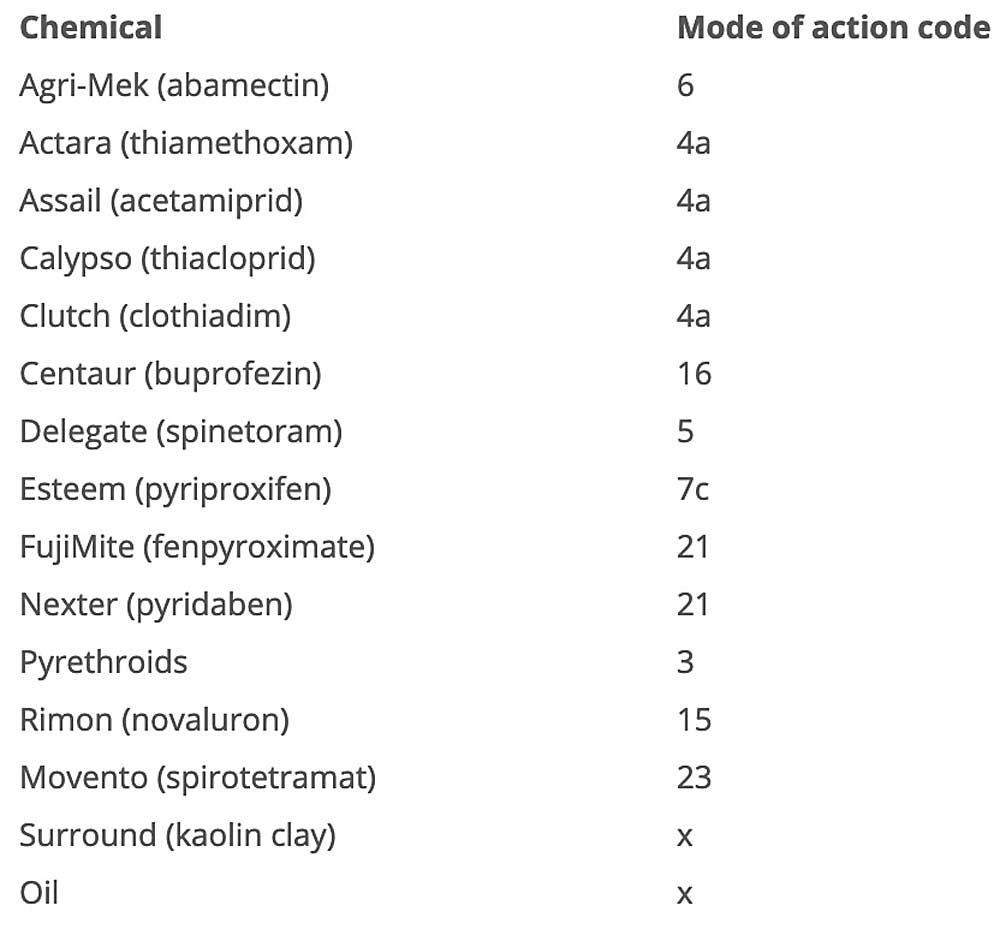
Pear psylla nymph and early in-star stages.
Pear growers have many tactics to use in their integrated pest management programs. But figuring out how to use them to prevent insect resistance is the hard part, says Dr. John Dunley, Washington State University entomologist.
Orchardists now have chemicals available with more than eight different modes of action that are registered for pear psylla control, the pest that drives most pear IPM programs in the Pacific Northwest. “Resistance management is critical so that we can continue to have these tools around for a long time,” Dunley said during the North Central Washington Pear Day held in January in Wenatchee.
“There’s no reason for resistance as long as we rotate materials and practice resistance management,” he said.
The insecticide class of neonicotinyls is the group that he is especially worried about. “The year 2007 really highlighted the problem with the neonicotinyls,” he explained. “In 2007, five different neonicotinyls with the same mode of action (Actara, Clutch, Assail, Calypso, and Provado) were used between four to six times in the season, one right after another. This is a recipe for resistance.”
Resistance to the neonicotinyl class has already showed up in pear orchards in Dryden, Washington, he noted. Resistance is slowly developing and is now more widespread. “We’re not getting the same level of kill from the neonicotinyl class that we did in 2001 and 2002 when Actara (thiamethoxam) first came out. Actara is being affected, so we have to reduce the amount of neonicotinyls we use.”
Dunley said that there have been reports from Oregon and California researchers of pear rust mite resistance to the new Delegate (spinetoram) product that works similar to Success (spinosad), but WSU entomologists have not seen problems yet in Washington.
Getting good spray coverage and timing spray treatments to be done at the optimum time can greatly help increase the efficacy and affordability of IPM programs, he noted.
“For pear psylla control, slow down when spraying, avoid spraying in the wind, and prune to facilitate spray coverage,” Dunley said. “Look for pear psylla nymphs and early instars and time your sprays before the insects have hard shells. And, don’t use the same mode of action against more than one generation.”
Resistance management
When considering which chemicals to use as part of an IPM program, Dunley suggested that growers pick a tactic that can affect more than one pest. “You need to consider the overlap of pest generations and which pests you are targeting,” he said, emphasizing that growers must try to get the most out of the insecticides they use.
For example, with three major periods to control pear psylla, a spray timed for pear psylla during prebloom to petal fall could also control the first generation of grape mealybug, if the proper chemical is used. However, there is little to no overlap when the second generation of grape mealybug appears, so a different material may be needed.
Dunley outlined the following steps growers should take in developing a resistance management program for pear psylla:
1. Don’t use the same chemical mode of action throughout the year.
• Rotate modes of action between generations.
• Use any mode of action against only one generation in a season.
2. You can use a material multiple times against one generation, if the label allows.
• Use multiple modes of action against any one generation, just don’t use them against another generation later in the season.
• Use any mode of action only during one of these key periods—dormant through petal fall (first codling moth generation), mid-June through mid-July (second codling moth generation), and August through harvest.
3. Example of an IPM program:
• Delayed dormancy—use materials like Surround, pyrethroid
• Cluster bud—Surround, Rimon
• Petal fall—Agri-Mek, Rimon
• Petal fall + 2 weeks – Proclaim or Esteem
• Midsummer—Delegate, Centaur, Centaur, Delegate
• Preharvest—Fujimite, Nexter
“Such a program would keep the neonicotinyls out of there to help with resistance management, but they would still be in our back pocket just in case there’s a problem,” Dunley said.
2008 review
In general, pear growers had more success with their IPM programs in 2008 compared to past years, Dunley said. “Overall, it was an expensive program last year, but it worked very well… We didn’t have any train wrecks, and there weren’t sticky pears at harvest.”
Factors that contributed to successful IPM programs included the weather and a new tool in the IPM arsenal. A long, cool period in the spring after pear psylla eggs were laid helped with natural mortality and reduced egg populations at the start of the season. Also, the insect growth regulator Delegate was registered by midsummer and helped with pear psylla and codling moth control.
He described Delegate as a straight residual product—one that doesn’t have to be absorbed by the leaves. With Delegate, an aging or hardened leaf does not reduce efficacy, compared to other products that are more readily absorbed when the leaf is actively growing.
“We haven’t had a product with good residual activity since Agri-Mek
North central Washington orchardists, generally, were also able to use one less acaricide and one less neonicotinyl in 2008, he added. However, grape mealybug and aphids showed up in several pear orchards. Aphids actually caused damage in some orchards, he noted. Dunley warned growers to be aware of those two pests in 2009 and consider them in their IPM programs if they had problems the previous year.

Mode of action (MOA) code: A pesticide’s mode of action will be listed on its label and given a MOA code for the different modes of action. The following are the mode of action codes for insecticides registered to control pear psylla:

Leave A Comment